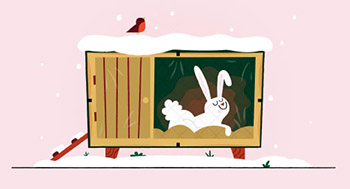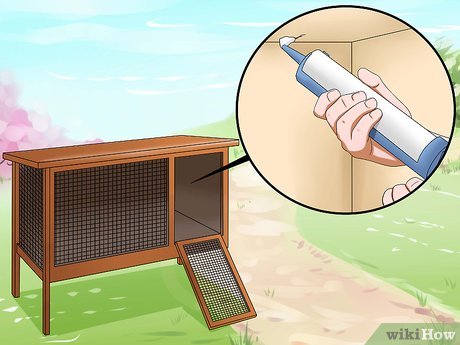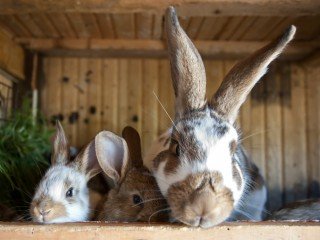While the winter season is arriving briskly, we must give thought to the animals around us. Rabbits are one of the few pet animals that require most of your care and affection. Unlike humans, they cannot express their needs to us. Instead, it is we who are to take charge and attend to their unspoken necessities. Isn’t that what love is? To see the requirements of your beloved without them having to say so.
Can rabbits stand the cold weather on their own?
Your rabbit may look like the most fragile creature alive; however, the truth is quite contradictory. By nature, they are equipped to deal with any situation that they would have to fight against. Most of them, at least. Similar is the case in terms of rabbits being able to get through winters. Rabbits are winter animals who can not only survive but also thrive in the snowy season. A compelling fact may be that your bunny would be more in need of your assistance in a hot environment instead.
Regardless, if they are put in the wrong conditions to battle with the weather’s extremity, the probability of them losing the fight would be relatively high. Your precious furball may fall victim to an illness or hypothermia. Following the ancient proverb, a stitch in time saves nine. It is always better to provide your bunny with heating measures to turn any approaching risk direction. If you are the pet owner of a smaller breed of these adorable furry beings, it is almost obligatory that you take action according to the cold weather conditions. Larger breeds of rabbits tend to trap heating inside their bodies, whereas smaller species lack in this department. This not only makes them an easier victim to winter miseries but also more in need of your kindness.
Can the cold season be fatal to my rabbit?

In the majority of the cases, rabbits adapt well to the weather condition around them. Pet rabbits are likely to not be as unbeatable by an illness as their fellow breed wild rabbits maybe. Hypothermia is one of the states in a rabbit that can prove fatal to it. As it cannot store more heat than it gives away to the environment, it will be at the mercy of the weather. It is common in weather conditions where the temperature is below 40 degrees. If you suspect your rabbit is suffering from hypothermia, contacting the vet at the pick of any hypothermia system would be your best doing, considering the circumstance. However, we need not worry! Your rabbit will be able to beat hypothermia along with your help. There is nothing that you and your best friend can’t succeed at together…right?
What measures can I take to keep my rabbit warm in winter?
Rabbit hutches and improvements to be made in them. Suppose you keep your rabbit outside the premises of your household. The very first thing that you can do in order of priority is to go for an inspection of its hutch. Even if you are sure, you only checked yesterday. Knowing how jumpy and playful rabbits can be, it is better to be on the safer side. Mending and repairing its place of living to shut the entry of chilly winds will unquestionably keep your rabbit safe.
Equipping the rabbit hutch with insulation material.

Covering the hatch’s roof with a blanket will also make it warm and comfy for the rabbit. It will promise your adorable friend a good night’s sleep. It should be noticed that the blanket suffocating the hatch does not create a suffocating impact. For this reason, the blanket should be removed when the sun is out.
Change the placement of the hatch or the place of living of the rabbit.
All of us may not have the expense to shift the rabbit hatch to inside the house; nonetheless, if you are someone who can afford to do so. Living in a country or area where winters are harsh; will be the most favorable step you can take to keep your rabbit safe. Albeit, don’t feel guilty in case you are unable to do so. There are countless other alternatives you may go to make up for your rabbit.
Exercising in the winters
It is just as important for your rabbit to exercise as it is for you! Rabbits being social and outdoor creatures, require their physical body to be continuously met. In the winters, it is exceptionally essential. Exercising will get the rabbit to be warmed and get the blood in your rabbit pumping literally. You can provide your rabbit with toys in their hatch if there are no other bunnies to provide it company. Most rabbit owners prefer attaching a swing or climbing slope inside the rabbit’s living space. In this manner, your rabbit may exercise according to the time of day it deems suitable.

Food intake of a rabbit in winters
The appetite of a rabbit increases twice as much in winters as compared to summers. As a rabbit parent, it is your responsibility to cater to your stomach’s requirements. You might need to increase your budget for pet food for the winter months! Being fed double the amount of nutrition and proteins will keep it full of vitality. This will help the little fellow keep itself warm when it is well fed. You will also feel victorious as a pet parent – bonus point.
Sleeping arrangements in winters
Sleep is a vital part of any living being’s life. If your rabbit has spent the night sleeping cozily, the probability of it having an energy-filled day the next morning is exceptionally high. For this reason, ensure your rabbit has a good night’s sleep in winter. Providing the rabbit with extra hay or a heating pad in its hatch will specify a spot of warmth in its lovely home. However, make sure the hay that you provide to the bunny is dry and significant in quantity.
Did you know?
You might be of the view that straw can be used as an easy alternative to hay. While in reality, straw, which might not seem as sharp to you, is the opposite of your rabbit. In some specific cases, it has come out as the cause of injury in rabbits as well. Knowing you would not even put your rabbit at the risk of a prick, we suggest you go for hay at all costs. If you come across an issue of availability, a heating pad is the next best option. They are likely to be at your reach from any local supermarket easily.

Water bottles freeze.
It is a fact of common knowledge that water bottles are frozen in extreme weather conditions. This may deprive your rabbit of water at a time when it is required. Being unable to communicate its thirst level to you will sit helplessly waiting for you to attend to it. It is reasonable for you and the rabbit to swap water bottles or utensils provided to the animal twice in the day.
As a human, you can forget to add this to your repetitive list of chores. However, this hassle can simply be avoided by setting up a reminder on your phone or wristwatch. After a couple of days, you will be accustomed to replacing the bottle yourself.
Conclusion
Let us wrap up and summarize the entirety of this discussion for you.
Rabbits may look fragile when it comes to any inexpedient plot, such as harsh weather. Nonetheless, their body structure and fur coats allow them to adapt relatively well to the cold winter breezes. Only the smaller breeds of rabbits are, due to their size, unable to sustain heat. What they need to survive the chilly months is a suitable environment. This will be achieved by taking extra precautionary measures against the climate, such as adding more hay to the rabbit’s sleeping place, changing their hatch’s position, etc. It is only in the rarity of cases that a rabbit loses its life to the cold weather. The majority of fatal cases are due to hypothermia. It is no lie that hypothermia is excessively harmful if put in comparison to a casual fever. At the same time, it is also not true that hypothermia can be bettered with the right help from you and the vet. You might stop holding your breath if you were still anticipating the worst news. We are confident your rabbit is in the best of hands (yours, duh!)
We hope to have taught you noteworthy information and tips in exchange for your precious time. May you and your fluffy get to cherish and enjoy every lasting moment of the winter, the boost of your health.
